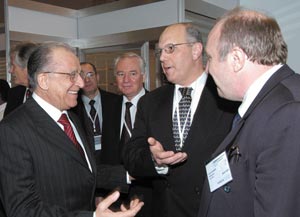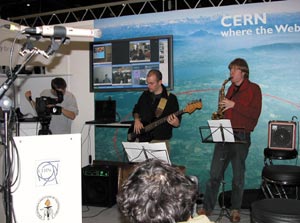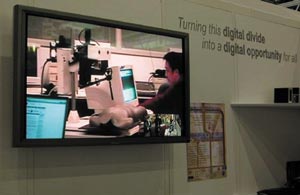Recent major exhibitions have provided the opportunity to demonstrate the potential of the high-speed link between Europe and North America, as Chris Jones reports.

In two world exhibitions in Geneva in 2003, a collaboration between Caltech, CERN and other international institutes set out to demonstrate the possibilities and opportunities provided by the DataTAG transatlantic high-speed “light path”, which currently allows data transmission rates up to 10 gigabits per second (Gbps). The Services Industriels de Genève extended the light path into the heart of the exhibition floor in Geneva’s exhibition centre, Palexpo, both for ITU Telecom World 2003 in October and the Information and Communication Technologies for Development (ICT4D) exhibition at the World Summit on the Information Society (WSIS) in December.
A substantial, portable data centre was built on the exhibition floor in collaboration with Telehouse, CERN’s partner in the CERN Internet Exchange Point (CIXP), which is the major centre for interchange between telecommunications operators in the Geneva area. The CIXP was extended directly to the stand in Palexpo and the DataTAG light path was able to provide 10 Gbps Ethernet connectivity from the stand to collaborators in North America – Los Angeles and Chicago in the US and Ottawa in Canada. (Ethernet has come a long way from the days when it was considered to be a technology fit only for very-local-area networks!) The equipment to operate the DataTAG link at these highest state-of-the-art speeds was provided by CISCO, Intel and HP at several points on the light path.
The aims of the two world exhibitions were slightly different. Telecom World 2003 continued the 20 year tradition of CERN’s involvement in demonstrations of the latest high-speed networking, and succeeded in breaking – yet again – the Internet2 records for high-speed data transmission over long distances. The ICT4D exhibition at the WSIS focused on demonstrations aimed at “turning the digital divide into a digital opportunity”, in line with the summit’s declarations.

Nonetheless, a number of items were common to both exhibitions, such as the Virtual Rooms Videoconferencing System (VRVS), which runs over the Internet; the Grid Café portal, which aims to explain and demonstrate the Grid and is proving extremely popular as a website; and the MonALISA system, which was developed by Caltech and portrays in an elegant and highly visual manner the performance of a worldwide networking system or the machines in a world Grid, and demonstrates how essential such systems are to the successful operation of Grids.
The VRVS system was fundamental to many of the demonstrations. It showed its use for international collaboration in virtual organizations, as well as in e-learning and e-lectures of several varieties, including Tokyo Lectures, a global teaching project in modern artificial intelligence in conjunction with the Swiss Education and Research Network; an impromptu presentation from the stand to the e-health conference in London; and direct sessions to the Internet2 conference in Indianapolis, including the ceremony where Harvey Newman from Caltech and Olivier Martin from CERN jointly received two Internet2 Landspeed Record awards over the Internet and announced that these records had already been broken again during Telecom World 2003.
VRVS was also used when the Romanian president, Ion Iliescu, made an extended visit to the ICT4D stand at WSIS and participated in a videoconference with his compatriots back in Bucharest. President Iliescu was also able to appreciate the efforts of his compatriot Iosif Legrand, who has made the major contribution to MonALISA. E-learning and the global transmission of lectures is a strong point of such systems, especially in the context of WSIS, and plans for such exploitation are now taking off in a really meaningful manner.

Two of the highlights on the ICT4D stand were provided by a collaboration with the Communications Research Centre in Canada. A remote “touch and feel” demonstration of haptic feedback allowed visitors to the stand in Geneva to “shake hands” with people in Ottawa and to feel the body of a dummy, as is necessary in telemedicine. This equipment is being used on a real basis in Canada for trials of remote operations. The final “bouquet” was a jazz concert, with musicians on both sides of the Atlantic playing together. Musicians from the Geneva Conservatoire de Musique played along with those from the Holy Heart of Mary Secondary School in St John’s in Newfoundland. This two-hour session demonstrated the well-developed ability of musicians to adapt to delays of a few hundred milliseconds, and the show was closed by a final jam session.








